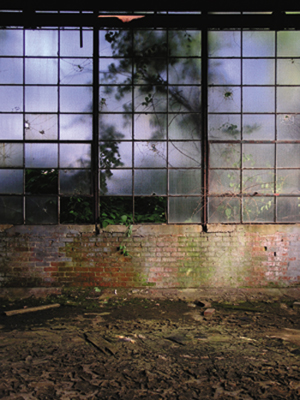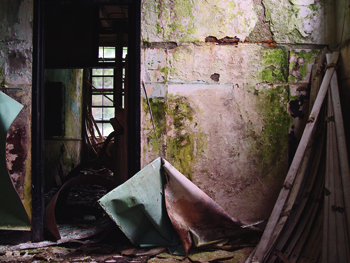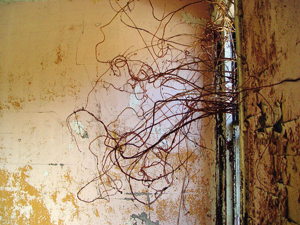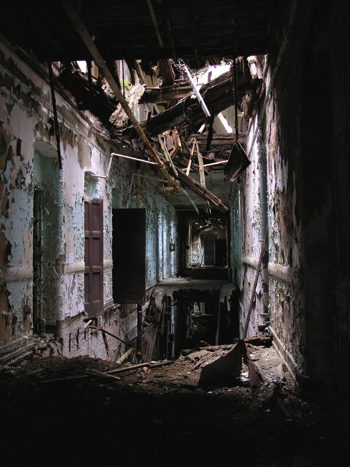Alan Weisman is an award-winning environmental journalist whose reports have appeared in Harper’s, the Atlantic Monthly, the New York Times Magazine, and Discover, and on National Public Radio; he teaches international journalism at the University of Arizona. His New York Times best seller The World Without Us, called by critics an “eco-thriller” and “one of the grandest thought experiments of our time,” considers the fate of the earth were human beings suddenly to disappear. In August, Tricycle contributing editor Clark Strand spoke with Weisman about impermanence, human responsibility, and the initiation into a new way of global thinking.

The World Without Us begins with a brilliant example of what Buddhists call “skillful means.” You ask us to imagine that, for whatever reason, human beings have now become extinct. The problem in writing about the kinds of environmental issues I raise in the book is that they produce so much anxiety. Readers just can’t take them in. So I kill us all off right from the start and that anxiety is effectively gone. It’s a way of saying, “Hey, don’t worry. You can take your time and really look at all this stuff, because we’re already out of the picture now.”
I was reminded of certain classical Buddhist visualizations in which one imagines the death and decay of one’s own body. The result is much the same: You’re left with an awareness that, because it is no longer centered upon, the self is greatly expanded in the kinds of truths it can take in. How much of this did you know already? Certainly a lot of the more subversive, mind-boggling information in the book I discovered in the course of writing it. I mean, I seriously never understood how urgent and dangerous the situation with nuclear waste is. I’d been talking to antinuke people for years, but I never really got a sense of how much waste comes out of our reactors, or the fact that we really have no idea whatsoever what to do with it. So it’s just sitting out there in temporary storage.
And meanwhile we’re just making more and more of it by the minute. Absolutely. And we can’t get rid of it, we can’t hide it, and there’s no safe way to contain it.
But your eyes had been opened from so many years of reporting on events like the meltdown at Chernobyl. Yes. But the truth is, I’d gotten to the point in life where I was getting so jaded by all the environmental coverage I’d done that I sometimes couldn’t imagine going on with it.
But with this book you found a radically new way of thinking about the whole problem and of writing about it. People have described the experience of reading your book as a definitive moment in the development of a collective ecological awareness, like first encountering Rachel Carson’s book Silent Spring. Yes. One interviewer compared it to the first Earth Day, which was inspired by photographs of Earth taken from outer space. For the first time, we got far enough from the Earth that we could turn around and take a photograph of it, and what we saw completely changed our way of looking at the planet. We were mesmerized by how beautiful and utterly unique it was. And that new way of seeing the planet in its totality yanked our consciousness to a whole new level of reverence and of concern. Immediately the environmental movement sprang to life. That same interviewer suggested that The World Without Us gives a similar kind of distance by extracting human beings from the equation, allowing us to think about the planet on its own terms, apart from the innumerable distractions and noise of human life. It’s a way of tearing down the walls that separate us from nature.
You write about tearing down those walls in the chapter “Unbuilding Our Home.” You quote a farmer who said that if you wanted to tear down a barn all you had to do was cut an eighteen-inch-square hole in the roof, then stand back and watch. How’s that for impermanence! Yes. Well, it’s pretty much the same for everything else we have built. They begin to fall apart almost immediately once we’re gone.
You predict that within twenty years or so there would be a river flowing straight down Lexington Avenue through the middle of Manhattan because once the subways flooded, which would happen within a couple of days, it’s just a matter of time before the streets above them begin to cave in. New York City is in many ways the epitome of human civilization. But, again, it’s the same for almost everything else we’ve made.
And yet, life goes on. As I read your book I kept coming back to a modern Buddhist description of Buddha as life itself, or even the “life force” inherent in nature. Does this concept make sense from your point of view? It makes perfect sense. If I were asked to sum up what the book is about, I think I could bring it down to two ideas. The first is that there’s something wonderfully mysterious and comforting in how indomitable life seems to be. Because the very worst stuff can happen—for instance, the Permian extinction, which occurred roughly 250 million years ago, where you have a million years of volcanic eruption through the carboniferous layer of the planet, and possibly an asteroid to boot, and so the planet gets whacked down to where there’s almost nothing moving . . . and then life starts to crawl out of the sea again. Or there’s the most infertile space you could possibly imagine, be it a highly contaminated chemical weapons site or the place where two very cold pieces of steel come together to form the union in a bridge. And given the least opportunity, life springs right out of those cracks. Life does amazing things to fit changing circumstances and survive.
But surely it’s not indestructible. Eventually the sun will explode. Yes. But life may go on even after the earth has been reduced to a cinder, because despite our best attempts at perfect sterilization, microbes are attaching themselves to the crafts we send into outer space, and when those spacecrafts come back to earth they’re still there. And so there are probably some on the Voyager spacecraft we sent out back in the 1970s along with a record of our music and everything else. So, who knows?

So what’s the second idea? The other thing is that, even though the world will go on without us in the event of our extinction, we shouldn’t be too quick to give up on the human race. The whole book is really a way of getting people to imagine, first of all, how amazing the world would be without us, and second, how we might add ourselves back into this equation. We could still be a part of it. But then, there are a lot of things that we should do now in order to make sure that happens.
Like finding renewable, nonpolluting energy sources and putting a halt on the production of nuclear waste? Yes. But basically it’s more urgent than that at this point. We’re dealing with a numbers game here. Every single species out there whose population exceeds the limits of its resources eventually goes extinct, or at any rate finds its population scaled way, way back.
“It gets too big for its box.” That was the way you put it. Well, yes. In other words, we run up against a population crash. And so we have the choice of correcting that trend ourselves or letting nature do it for us—which isn’t going to be pretty, because nature is efficiently and magnificently brutal.
But returning for the moment to a Buddhist perspective, aren’t we really talking about a massive scaling back of what many practitioners might call “the self,” with all its insatiable desires and ambitions, few of which have anything to do with what we actually need? I would agree with you to a point. But my idea of the self is much more biologically than spiritually based. Though I believe that there’s something transcendent and mysterious in life, I’ve stopped trying to define it. I think that our role as spiritual creatures is not to try to solve that mystery but to learn to dwell in it. Also, you have to realize that our biological, selfish needs and desires aren’t just ours. Other species have them, too. It’s part of biology. A cat will hunt for the sheer pleasure of doing it and not just to satisfy his hunger. You’ve got a cat who’s totally satiated and if you put him outside and he sees a bird, he’ll go right into hunting mode. We do that, too. It’s wasteful, true, but it’s also something in us that’s just innate. And so even though chimpanzees stayed in the trees and didn’t follow us into the savannas when we evolved, they also exhibit a lot of our behavior. They can be brutal, petty, acquisitive, and ruthlessly competitive.

It’s that survival-of-the-fittest energy. True. And the survival of the fittest is great as long as you’re the winner. If you’re the loser, there’s a downside. Every species goes extinct sooner or later—that’s just the way it works. The reason things go extinct is sometimes because they have exhausted their available food resources, and sometimes because their environment has changed so much that they can’t adapt.
Or can’t adapt fast enough. Exactly. But in our case, we’re the ones changing our own environment. But again, we’re not the only species who do that. A swarm of locusts will work its way through all the available fields until it’s eaten itself out of house and home. Then, suddenly, its population crashes. So this is not a new behavior. It’s just part of the grand scheme of things. And, you know, I think the Buddha may have had a glimpse of just this.
Yes, but it’s one thing to say that all is impermanent, and quite another to apply that same logic to our own species. Nature being what it is, we’re all going to go extinct sometime. But because I live now, because I love other Homo sapiens, and because I love the world that I was born into, I think—even if it’s swimming against the inevitability of where the universe is ultimately headed—my role is to try to preserve the wonder of the world and the goodness that human beings create.
Is it crazy to think that we can change our behavior as a species when we don’t yet think of ourselves as part and parcel with the rest of nature? Yes and no. The chances that we will limit our population are at the moment rather slim. And yet there are glimmers that we might do it. Ten or fifteen years ago, only a few very well-informed people were warning us about global warming. Everybody else was busy coming up with the reasons not to believe in it. And yet I think that today, except for a few diehards out there, it’s understood to be real. And so now we’re beginning to think, what the hell are we going to do about it?
China has already tried to limit its population growth with its restriction to one child per family—which is the same solution you offer at the end of your book, noting that by 2100 we could scale back the human presence on Earth to nineteenth-century levels, with corresponding benefits to the overall health of the planet. But wasn’t the Chinese experiment considered a complete failure?Well, frankly, I don’t think it was a complete failure. Their experiment with population control pointed out a lot of the pitfalls, some of which were deeply tragic, like taking little girl babies out to the forest to die. At the same time, it’s also given us good ideas about how to start over once we realize we’ll need to try it again, and on a much greater scale than just China.
And the fact is, China did lower its birth rate, correct? Yes. And India, which did not try that experiment, will exceed the population of China by 2030, and on a much smaller land mass.
That’s just a little over twenty years from now. That’s why it was important to me to bring this argument back into the conversation, because the anti-abortion people in America had pretty much quashed it. When I began writing The World Without Us, I couldn’t find a single zero-population growth movement in the United States anymore. They’d changed their names to something much less offensive to their enemies. In other words, they’d backed down.
So what do we do when there are religious organizations, both in America and elsewhere, who tell us to do just the opposite of what clearly needs to happen to save the planet and ourselves? Not only is the Chinese experiment not necessarily the failure that we think it is, there’s actually another experiment going on right now that not only addresses the question of whether we can limit our population or not, but also responds to the religious issue of whether our spiritual authorities will permit us to. That example is called Italy.
Right now Italy has one of the best economies on the planet—next to Ireland, the best in Europe. It also has one of the lowest population-growth rates on the planet. And it happens to be the country that hosts the Vatican.
That almost seems bizarre. Are Italian Catholics taking their religion less seriously these days? Actually, I think Italians take their religion very seriously. If you ask them, most Italian Catholics will tell you that they believe in God, that they pray and go to Mass. The fact is, they seem to have discovered a way to be prosperous and happy and religiously inspired—and at the same time be responsible on the issue of population. They have fewer kids and happier families, and their quality of life has improved.

The Buddhist sutras frequently employ huge time spans in an effort to expand the minds of their listeners. Your book has a similar sort of effect in the way it deals with the geological record. We can’t really grasp geological time as human beings. We want to break time down to our scale, we want to think that human civilization as it’s existed for the past three or four thousand years of recorded human history is the sum, or even the point, of creation. We want to believe that we are what the world is about.
Yes. But your book really breaks that frame wide open, and shows us both an infinitely receding past, most of which did not include us, and a future that, with or without us, will go on into the infinitely distant future. It’s hard not to feel humbled by that vision of time. And yet there’s a kind of paradox there too, isn’t there? It’s supposed to be a world without us, but the book is filled with people, too.
True. The biologists and physicists and environmentalists and artists you interviewed are all right there on nearly every page of the book, speaking in their own voices about what would happen if we suddenly disappeared. In that respect, it’s a very densely populated book. The other day an interviewer said to me, “You know, The World Without Us is really a love letter.”
Well, I can definitely see that—a love letter to the planet. Well, no. It’s really a love letter to the human race.
What Would Happen Tomorrow if We All Disappeared Today?
1 Week: The reserve fuel supply to the pumps that circulate cooling water to the world’s online nuclear reactors would run out.
1 Year: Animals would begin returning to the sites of these reactors, which would by now all have burned or melted down. An estimated 1 billion birds that are now being killed each year would survive when electric power lines grow cold and the lights on communication towers go out.
3 Years: With no heat, pipes would burst in towns in cold or temperate zones, and the joints between walls and roof lines would separate as metal fixtures expand and contract.
20 Years: The Panama Canal has now ceased to exist, and North and South America are joined once more. Garden vegetables have reverted into wild strains and are no longer palatable.
100 Years: Without ivory trade, the world’s population of elephants has increased to 10 million, whereas the populations of raccoons and foxes are in decline since domesticated cats have entered the food chain.
300 Years: Along with many other cities built on river deltas, Houston has now been mostly washed away.
500 Years: Suburbs have been completely reclaimed by forest. Only aluminum dishwasher parts, stainless steel cookware, bathroom tiles, and plastic handles remain.
1000s of Years: What’s left of New York City is scraped clean by glaciers. Only some tunnels and other underground structures remain.
35,000 Years: The soil is finally clear of human-generated lead pollution; cadmium is still only halfway there.
100,000 Years: CO2 may now have returned to prehuman levels.
1 Million Years: By now microbes may have evolved that are capable of biodegrading the human legacy of plastics.
7,200,000 Years: The faces on Mt. Rushmore are still discernible. PCBs and Dioxin compounds are probably still intact.
4.5 Billion Years: The half-million depleted Uranium-238 has now reached its half-life. Earth warms as the sun expands. Once more, microbial life rules the earth.
5 Billion Years and Beyond: The earth has been incinerated by the sun. Radio and television broadcasts still drift through deep space as relics of our presence on Earth.
Thank you for subscribing to Tricycle! As a nonprofit, we depend on readers like you to keep Buddhist teachings and practices widely available.